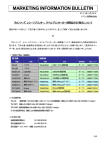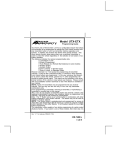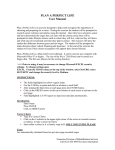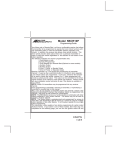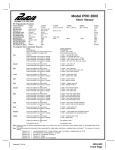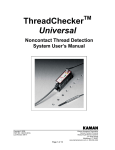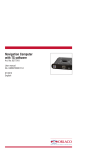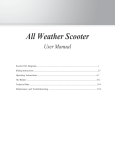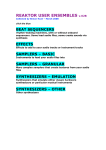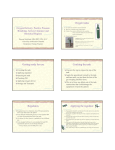Download Your Money, Your Future: User Manual for Partners
Transcript
Your Money, Your Future: User Manual for Partners A guide for IFC’s bank partners to successfully customize and launch the Your Money, Your Future student guide Introduction IFC has partnered with local banks and charitable foundations around the world to provide student loans to cover tuition fees at local universities. In many markets, student lending is a new financial service product, and there is little awareness among students of the costs, benefits, and potential risks of this type of financial product. Therefore, International Finance Corporation (IFC) has set out to provide the Your Money, Your Future curriculum to assist students and their families in making borrowing decisions, thereby enhancing their access to appropriate financial services. No matter their address or family background, youth around the world can benefit from learning more about personal finance. As they approach college age, youth are confronted with financial decisions that will impact their future in ways they could not have imagined before. IFC recognizes the significance of communicating directly with this age group, and thus developed the Your Money, Your Future curriculum. The curriculum is a self-guided resource for students in emerging markets who are thinking about college or attending college, and preparing for their futures. It covers topics from student loans to goal-setting to repaying debt, and aims to educate youth – and their families – in ways that will make them better money managers and more responsible borrowers throughout their college careers and beyond. This User Manual will help you capitalize on Your Money, Your Future by adapting it to create local relevance. The goals of this User Manual are to: 1. Familiarize you with the curriculum resources in their current state, 2. Help you identify opportunities to create local relevance, 3. Offer suggestions for customizing the curriculum, and 4. Recommend tactics for implementing the curriculum in your local market and gaining traction among students, their families, educators, and other important stakeholders. You are an important partner in this effort. By customizing the curriculum to your local market, you will increase the likelihood of a successful implementation. Thank you for your commitment to helping youth around the world become responsible and successful money managers. Your Money, Your Future User Manual for Partners 2 About the Curriculum Your Money, Your Future speaks directly to students who are preparing to enter college or who have recently begun their college careers. Although the curriculum may be implemented by financial partners or other facilitators, it was designed as a self-guided resource that students and their families can use in any setting. The curriculum is divided into seven separate chapters, each containing several pages of background information and two to three activities that encourage youth to think about and apply what they learned in that chapter. A summary of each of the seven chapters is included below: Chapter 1: Basic Financial Issues The first chapter of the curriculum encourages students to start thinking about their financial goals, to write them down, and to discuss them with their families. It also introduces the concept of opportunity costs, a theme that runs throughout the curriculum. Chapter 2: Creating and Managing a Budget Even if they never before kept track of their money, college students are faced with financial obligations that make budgeting an imperative practice. This chapter instructs students on how to create and maintain a budget, and offers tips for reprioritizing expenses to keep a balanced budget. Chapter 3: Student Loans Students who are engaged in the curriculum have a desire to pursue a higher education — many of whom may require financial assistance beyond what their families can provide. This chapter explores the basics of student lending, from forecasting one’s education expenses to researching a student loan’s terms and conditions. Your Money, Your Future User Manual for Partners 3 Chapter 4: Establishing Credit Students may not realize the level of responsibility connected with credit. Here, they learn the basics of qualifying for credit and evaluating credit products. They will review the different types of credit and when to use them, terms and conditions, and finance charges. Chapter 5: Managing Debt Once you have credit, how do you manage it responsibly? This chapter deals with that very question. It includes tips on avoiding the overuse of credit, reducing total debt, shortening repayment time, and reducing finance charges. It also includes an analysis of loan consolidation options. Chapter 6: Repaying Debt This chapter of the curriculum wraps up the discussion of credit by explaining different repayment options available to borrowers. It also examines the ramifications of not paying one’s debts on time, and how to work with a creditor if and when a student experiences difficulty repaying debt. Chapter 7: Saving and its Benefits The final chapter connects saving money with reaching one’s financial goals. It covers the importance of having an emergency cash reserve, explains the difference between saving and investing, offers tips to make saving money easier, and demonstrates the benefits of compound interest. After reading Your Money, Your Future and completing the activities contained therein, students will be armed with the knowledge and skills necessary to navigate the world of personal finance and avoid making costly money mistakes. Your Money, Your Future User Manual for Partners 4 Using the Curriculum in your Market IFC aims to create opportunity for people to escape poverty and improve their lives. Increasing financial literacy is key to sustaining this objective, particularly for young people such as students. As economic empowerment increases, so does the need for the knowledge and skills to navigate a world with greater financial decisions. IFC believes the Your Money, Your Future curriculum can make a difference in the lives of current and prospective college students in many emerging markets. Thus, we developed the content described in the previous section with relatively generic terminology, allowing it to be customized easily for local markets. This is where we need your help. As a local partner, you can play a key role in not only making the curriculum the most relevant for local students, but also in promoting its use among these students and their families. Further, your connections in local public and private sectors will help to maximize the number of students who will be impacted by this offering. Please read the following sections of the User Manual for guidance on how to adapt Your Money, Your Future to best meet the needs of students in your market, and for tips on leveraging local resources to broadly implement the curriculum and make a deep impact. Your Money, Your Future User Manual for Partners 5 Determining Local Relevance There are many questions you will need to consider in determining how to customize the Your Money, Your Future curriculum, introduce it in your country or region, and gain traction among students, their families, educators, and other important stakeholders. The following guiding questions will help you assess the current market for this type of curriculum and identify opportunities to create local relevance. There are likely some questions that you can answer immediately, while others will require you to do some deeper research. Additionally, answering a few of these questions require you to read the Your Money, Your Future curriculum. ◊ What customs exist that may affect how families/peers talk about money? Plan for college? ◊ What student lending and consumer finance products are available in your country/ region? How widespread is knowledge about these products? How widespread is use of these products? ◊ Are there any local laws or regulations that affect access to or use of student lending or consumer finance products? ◊ Are there barriers to widespread digital access of the Your Money, Your Future curriculum resources? What alternatives are available? ◊ Will the curriculum need to be translated? Into what language(s)? ◊ Are the photos and imagery contained within Your Money, Your Future appropriate for your local market? ◊ Are there any cultural references contained within the curriculum that may be inappropriate for your audience? ◊ Are there any cultural references that you could change to make them more locally relevant? ◊ Will curriculum references to currency, mark-up rates, or other financial numbers need to be changed? ◊ What academic organizations are influential in your country/region? Is there potential to partner with any of these organizations to adapt and/or implement the curriculum? ◊ If there are organizations that can help implement the curriculum, it may help to reference education guidelines/standards. Are there national or local financial education guidelines or standards that educators must follow? What is the process for aligning with these guidelines or standards? Which organizations set the guidelines or standards? By answering the above questions, you should gain a solid understanding of the market for the Your Money, Your Future curriculum and be able to identify areas that may need to be adapted or customized to best meet the needs of your local market. Your Money, Your Future User Manual for Partners 6 Customizing the Curriculum If you feel that you need to make curriculum changes, please discuss your ideas with IFC to ensure continuity with the approved messaging, positioning, and program objectives. Once your changes have been approved, you can begin the customization process. Your Money, Your Future is available in PDF and InDesign formats. If visual or textual references need to be changed for your local market, you will need to work with the InDesign file. Remember the following writing tips when rewriting or adding content to the curriculum: ◊ Remember the age of your audience. Speak to university-age students on their own level. ◊ Have someone else review and/or proofread your work. ◊ Consult with a local subject matter expert or educator if necessary. When converting currency or recalculating numbers, remember the following: ◊ Ensure that amounts and percentages are realistic for your local market. For example, are tuition costs typically higher in your country? Are mark-up rates typically lower? ◊ Use an online currency calculator to convert from the currency given as an example in the Guide into your local currency, if necessary. The following websites may be helpful for this purpose: - http://www.xe.com/ucc/ - http://www.x-rates.com/calculator.html ◊ Use an online credit card calculator to change the minimum payment percentage in the chart on page 56 of Chapter 6, if necessary: http://www.bankrate.com/calculators/managing-debt/minimum-payment-calculator.aspx When replacing images, keep the following tips in mind: ◊ Work with high-resolution digital photos, preferably in .jpg format. ◊ Do not use a photo of someone without his or her written permission. ◊ Research photos though stock photo agencies. ◊ Ensure that any stock photos you purchase are “royalty-free.” ◊ Include any logos for companies or organizations with which you have established partnerships. Their logos should be of a similar size or smaller than the IFC logo. ◊ Consult with a local design professional if necessary. Once all customizations are made, create a PDF of the curriculum for ease of distribution. If digital access is limited among your target audience, you also may wish to print the curriculum using a local vendor. Your Money, Your Future User Manual for Partners 7 Marketing the Curriculum With your curriculum customizations finalized, it is time to market Your Money, Your Future! In this section, we offer guidance and tips for marketing the curriculum through both internal and external channels. Before widespread distribution, you may wish to conduct a small pilot test of the curriculum to provide validation and ensure local viability. Select 4-6 students for the pilot; they could be family members of employees, local college students, or referrals from other stakeholders. Provide the pilot testers with electronic or printed copies of the curriculum, depending on how you will ultimately distribute it. Give them sufficient time to read the curriculum and complete the activities. Then, solicit feedback from students and their families on the content, activities, format, and design. Their feedback may prompt you to make additional changes to the curriculum before distribution. Additionally, their feedback can be valuable for marketing the curriculum. Solicit testimonials from participants that you can use as you promote the curriculum. Encourage participants to act as “ambassadors” for the curriculum — speaking highly of the resource among their peers. Finally, ask participants to point out the aspects of the curriculum that resonated with them — i.e., what they learned, what they enjoyed, etc. These aspects are likely to resonate with their peers, so your marketing efforts should emphasize them. Internal Channels IFC staff will present the curriculum to IFC partners, summarizing the content and purpose of the curriculum, and providing those partners with guidance on the use and application of the curriculum. This process will ensure that partners have appropriate expectations for the program and what their role is in delivering the curriculum. Additionally, in coordination with IFC staff, you will need to determine the following: ◊ How will this curriculum be delivered (e.g., instruction, self-study)? ◊ At what point in the borrowing process will this be delivered (e.g., at initial contact, after the student has agreed to borrow)? ◊ Will this be mandatory for student borrowers? ◊ What internal budget will you allocate for the delivery of this material? ◊ Who will be your internal champion for this project? You may also wish to spread the word within your own organization. Please consult with a local IFC representative for guidance on this process. This will ensure consistent messaging across all internal channels. Your Money, Your Future User Manual for Partners 8 External Channels When reaching out directly to the target audience, it is important to use consistent messaging in your promotion of the program. Student organizations and clubs can be effective forums for reaching students directly. Plan a launch event to help build support for the program among students, their families, and the general public. Moreover, capitalize on any existing communication channels, events, and partnerships to help promote the curriculum. Your Money, Your Future is also an opportunity to build new partnerships with local stakeholders to help market the curriculum, whether schools, government agencies, teacher organizations, or the media. Engage these partners early in the planning process to build support. This approach can help gain traction for the curriculum in areas you may not have reached using only your own channels. For Additional Information For additional information about Your Money, Your Future and how to best customize and implement it in your local market, please contact: Svava Bjarnason Senior Education Specialist IFC Health and Education Department Tel: +1 (202) 458-1306 Email: [email protected] About IFC IFC, a member of the World Bank Group, is the largest global development institution focused on the private sector in developing countries. We create opportunity for people to escape poverty and improve their lives. We do so by providing financing to help businesses employ more people and supply essential services, by mobilizing capital from others, and by delivering advisory services to ensure sustainable development. In a time of global economic uncertainty, our new investments climbed to a record $18 billion in fiscal 2010. For more information, visit www.ifc.org. Your Money, Your Future User Manual for Partners 9









